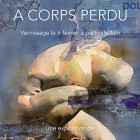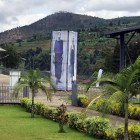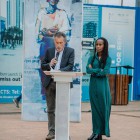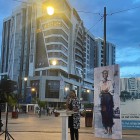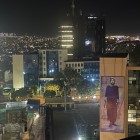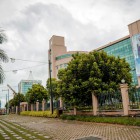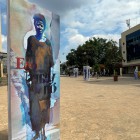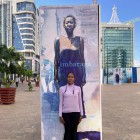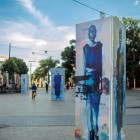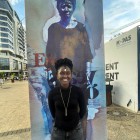
"Identity is not a fixed unmoving fact; it is fluid, a processes always in process by which one is continually making a distance between oneself and ones beginnings, in the same ay as the son leaves home and only returns through thoughts and feelings; it is something that gets lost and then is renewed in an incessant movement of change and return. A home-country or and identity cannot be owned in the way one owns property."
(Claudio Magris, Utopie et désenchantement, 2002, p. 92)
Born 1959, in London, his parents having recently emigrated from South Africa, Bruce Clarke Studied Fine Arts, Leeds University, Great Britain. Visual artist and photographer, based in Paris, he has exhibited in France and abroad since 1989.
His art deals with contemporary history, the writing and transmission of this history. He would like to see his work as stimulating reflection on the world and the representation which is made of it.
Recognising that art provides a privileged domain of expression in a complex world he situates himself outside of an overtly self-centred or over personalized form of contemporary art. Author of the on-going project, "the Garden of Memory" a memorial sculpture for the victims of the genocide of the Tutsis in Rwanda. The project has received the supported of UNESCO and is being realised in partnership with the principle associations of the civil society in Rwanda.
Photographer he has also published reportages on South Africa, Rwanda, the return of Liberian refugees, Palestine etc.
When he studied art at the Fine Arts Department of Leeds University, the dominant currents were representatives of a conceptual art movement close to Joseph Kosuth, the Art and Language group – a movement originating in the United States and later taking root in Great Britain. The main protagonists were Terry Atkinson, David Bainbridge, Harold Hurell and Michael Baldwin. This movement was at the crossroads of philosophy, logic and artistic theory. The artists who adhered to it questioned the relationship between art and discourse through different forms of artistic, social and political actions. They also questioned the role and the meaning of the art object itself, with, in the end, the idea of making the object disappear, leaving only idea. It is clear that at the centre of Bruce Clarke’s work there is a preoccupation with the convergence of questions of politics and language in the realm of visual arts.
"Words aren''t enough", "I am therefore I act", "Language at war", "Piège de son histoire". One only needs to skim over some of the titles of his works to see that one of his main preoccupations is the question: can visual creativity “act as a springboard to place political concerns at the centre of the public space; should it get more deeply involved, incisively, critically on order to allow a political reading of events to break into the art world…? But unfortunately, as we all know, it isn’t art that changes the world: art can only talk, or show”.
An active commitment
"Our humanity demands that we give, even it be in the space of a brief instant, face, name, voice and living memory to the hundreds of thousands of victims so that they aren’t merely synonymous to numbers, or worse still, thrown into the depths of forgetfulness or at best left sleeping in a few tables of statistics more or less officially recognised by the consciousness, which we call collective."
(Abdourahman A. Waberi, Moisson de crânes, (Harvest of skulls) Texts for Rwanda, p. 17).
No artist is isolated from his socio-political environment. His or her activity as a visual artist is, in itself a commitment, a critical commentary on the world. For Bruce Clarke his artistic work is inseparable from his political activism, firstly in relation to South Africa where he played a role on the anti-apartheid movement in France and with the ANC (African National Congress). He continues working on cultural projects in this country, particularly with the Afrika Cultural Centre in Johannesburg.
In the early 1990 s, Bruce Clarke closely followed, with his exiled African friends in Paris, the evolution of the war in Rwanda and the first signs of the genocide before coming face to face with the horror in August 1994 when he travelled on behalf of a collective of associations with which he was working, protesting against the open preparation of genocide. Thus was born the first ideas for the “Garden of Memory” which was enthusiastically welcomed by the institutions and civil society associations in Rwanda and which goes well beyond a simple artistic production. It is a project in progress close to Kigali.
"At that point, I began to reflect on the period after genocide. What role can an artist play in the preservation of real, living memory? Can he contribute to the psychological reconstruction of a totally traumatised population? With this project we had to make the reality of genocide tangible. What was left after the genocide, what we could see, wasn’t human anymore. It was a sort of abstraction: bones, mummified bodies. But these people had really existed; they had been people like you and me, who had a life behind them, a life now completely annihilated."
"That was the beginning of my reflection. Genocide had taken place in Rwanda. Approximately one million people had been killed. But each person killed had been an individual, with a face, occupying space. Wole Soyinka, the Nigerian writer has said that when a person is killed, it’s a tragedy, but when a thousand people are killed, it’s only a statistic. That’s what had to be avoided at all costs. It was fundamental to give back faces and individuality to the victims of tragedies, such as those in Rwanda, Palestine or elsewhere in the world. So the project, the Garden of Memory came out of a reflection on the way in which an artist can intervene in a very real situation. I had two principal preoccupations at the beginning of the project: How to take into account the enormity of what a genocide is – up to a million people killed. And at the same time it was essential to give a sense of humanity to each victim."
"As a foreign artist, I didn’t feel that I had the right to work with such sensitive material as human remains. I didn’t want to deal with it from that point of view, for obvious reasons. Distance had to be maintained. But how do you take distance as an artist? I thought that the distance could be found through inanimate matter – stone – which is abstract and at the same time full of symbolic meaning. That’s how I decided that the basic material for the Garden of Memory would be stone. But the garden wasn’t destined to be a place evoking horror; it had to be a place of contemplation. Where people could come and stroll. A garden is a place of renaissance; it isn’t a cemetery, or a place of death, even if it’s very pregnant with meaning. Besides this, the realisation of the project had to be done in strict collaboration with Rwandese civil society: the survivors, the women’s associations…"
"The Garden of Memory is a collective work. Even if the conception is mine, the project wouldn’t have any meaning if there wasn’t large scale participation in its realisation, or if the people involved didn’t fully understand the project and adhere to its ideas."
"The basic concept is very simple: it’s an individual act of memory in remembrance of an individual victim. This individual act is accomplished by a relative or close friend of the victim. The individual act is the posing of a stone with a mark on it. The person who puts the mark on the stone isn’t obliged to explain the mark to anyone. The mark can be a name or something abstract, but it must be an inscription in memory of a victim. Such an individual act of memory could be seen as a cathartic process opening the moment of mourning. So it’s this individual act of memory that we want "quite simply" to multiply by a million; make up a collective work composed of a million stones, each one being individualised and posed by someone close to the victim of the genocide. Posed according to a geometric schema that will evolve with time."
The Garden of Memory was first inaugurated on the 5th June 2000 in an important cultural manifestation, Fest’Africa in Rwanda. It is an on-going project.
How can art influence or comment on the course of history?
This is the principal and basic question that the Bruce Clarke, as a visual artist is asking himself through his life and work.
Text : Michèle Baj-Strobel



